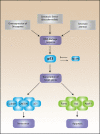Insights into 4E-BP1 and p53 mediated regulation of accelerated cell senescence
- PMID: 21399233
- PMCID: PMC3248149
- DOI: 10.18632/oncotarget.221
Insights into 4E-BP1 and p53 mediated regulation of accelerated cell senescence
Abstract
Senescence is a valid tumor suppressive mechanism in cancer. Accelerated cell senescence describes the growth arrested state of cells that have been treated with anti-tumor drugs, such as doxorubicin that induce a DNA damage response. Discodermolide, a microtubule-stabilizing agent, is a potent inducer of accelerated cell senescence. Resistance to discodermolide is mediated via resistance to accelerated cell senescence, and is associated with reduced expression of the mTORC1 substrate, 4E-BP1 and increased expression of p53 [1]. Although the association of p53 with senescence induction is well-characterized, senescence reversion in the presence of high expression of p53 has not been well-documented. Furthermore, studies addressing the role of mTOR signaling in regulating senescence have been limited and recent data implicate a novel, senescence-associated role for 4E-BP1 in crosstalk with the transcription factor p53. This research perspective will address these somewhat contradictory findings and summarize recent research regarding senescence and mTORC1 signaling.
Figures



Similar articles
-
Resistance to discodermolide, a microtubule-stabilizing agent and senescence inducer, is 4E-BP1-dependent.Proc Natl Acad Sci U S A. 2011 Jan 4;108(1):391-6. doi: 10.1073/pnas.1016962108. Epub 2010 Dec 20. Proc Natl Acad Sci U S A. 2011. PMID: 21173253 Free PMC article.
-
Autophagy impairment induces premature senescence in primary human fibroblasts.PLoS One. 2011;6(8):e23367. doi: 10.1371/journal.pone.0023367. Epub 2011 Aug 8. PLoS One. 2011. PMID: 21858089 Free PMC article.
-
An indirect role for ASPP1 in limiting p53-dependent p21 expression and cellular senescence.EMBO J. 2012 Jan 18;31(2):471-80. doi: 10.1038/emboj.2011.402. Epub 2011 Nov 8. EMBO J. 2012. PMID: 22068052 Free PMC article.
-
Reappraisal to the study of 4E-BP1 as an mTOR substrate - A normative critique.Eur J Cell Biol. 2017 Jun;96(4):325-336. doi: 10.1016/j.ejcb.2017.03.013. Epub 2017 Apr 8. Eur J Cell Biol. 2017. PMID: 28427795 Review.
-
Targeting cellular senescence in cancer and aging: roles of p53 and its isoforms.Carcinogenesis. 2020 Aug 12;41(8):1017-1029. doi: 10.1093/carcin/bgaa071. Carcinogenesis. 2020. PMID: 32619002 Free PMC article. Review.
Cited by
-
PKCι depletion initiates mitotic slippage-induced senescence in glioblastoma.Cell Cycle. 2015;14(18):2938-48. doi: 10.1080/15384101.2015.1071744. Cell Cycle. 2015. PMID: 26208522 Free PMC article.
-
mTOR kinase-dependent, but raptor-independent regulation of downstream signaling is important for cell cycle exit and myogenic differentiation.Cell Cycle. 2014;13(16):2517-25. doi: 10.4161/15384101.2014.941747. Cell Cycle. 2014. PMID: 25486193 Free PMC article.
-
Potential anti-aging agents suppress the level of constitutive mTOR- and DNA damage- signaling.Aging (Albany NY). 2012 Dec;4(12):952-65. doi: 10.18632/aging.100521. Aging (Albany NY). 2012. PMID: 23363784 Free PMC article.
-
Rapalogs in cancer prevention: anti-aging or anticancer?Cancer Biol Ther. 2012 Dec;13(14):1349-54. doi: 10.4161/cbt.22859. Epub 2012 Nov 14. Cancer Biol Ther. 2012. PMID: 23151465 Free PMC article. Review.
-
NRF2 and p53: Januses in cancer?Oncotarget. 2012 Nov;3(11):1272-83. doi: 10.18632/oncotarget.754. Oncotarget. 2012. PMID: 23174755 Free PMC article. Review.
References
-
- Hayflick L, Moorhead PS. The serial cultivation of human diploid cell strains. Exp Cell Res. 1961;25:585–621. - PubMed
-
- Hayflick L. The Limited in Vitro Lifetime of Human Diploid Cell Strains. Exp Cell Res. 1965;37:614–36. - PubMed
-
- Momand J, Zambetti GP, Olson DC, George D, Levine AJ. The mdm-2 oncogene product forms a complex with the p53 protein and inhibits p53-mediated transactivation. Cell. 1992;69(7):1237–45. - PubMed
Publication types
MeSH terms
Substances
Grants and funding
LinkOut - more resources
Full Text Sources
Research Materials
Miscellaneous

